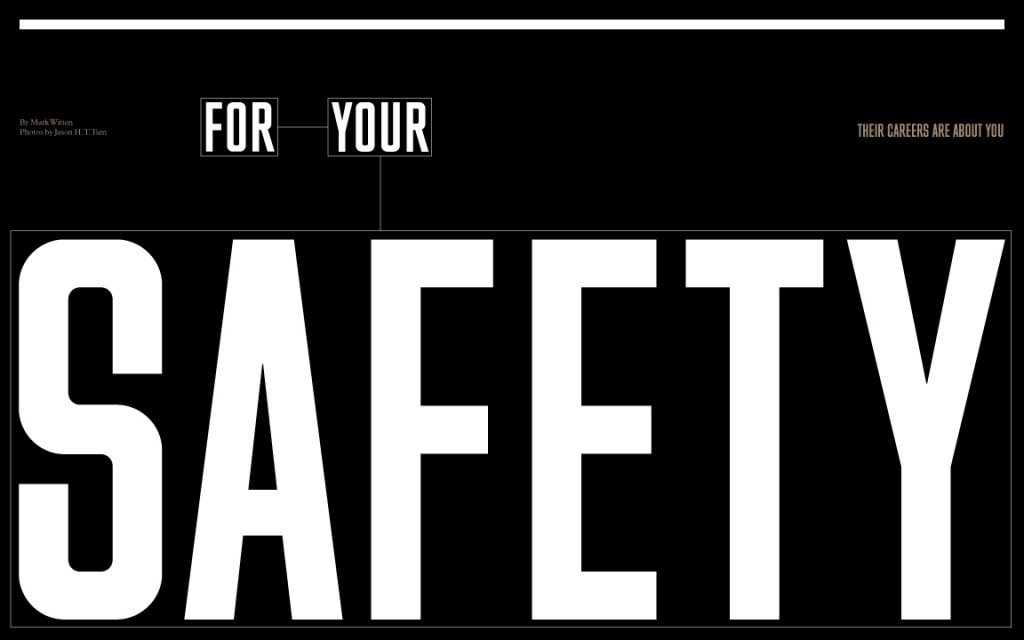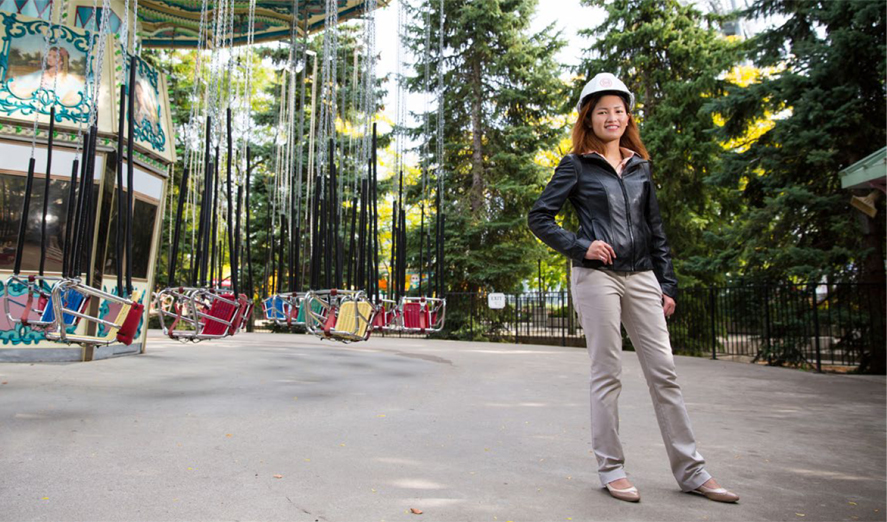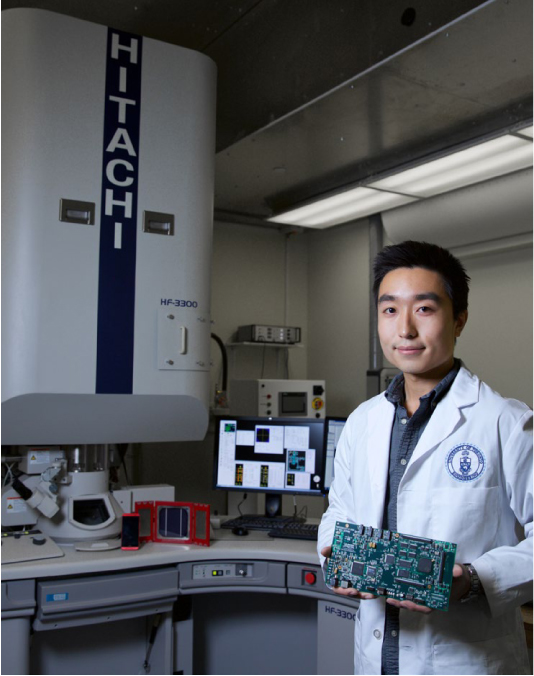Their careers are about you—meet the engineers whose jobs are to mitigate risks and help keep us safe
[sharexy]
By Mark Witten | Photos by Jason H. T. Tam


Alumna Katherine Allan—clinical research coordinator at St. Michael’s Hospital in a basic life support training classroom
Katherine Allan (MSE 0T2, MASc 0T5) helps save lives. According to the Canadian Journal of Cardiology, more than 90% of Canadians who suffer a sudden cardiac arrest outside of a hospital do not survive.
As a clinical research coordinator at St. Michael’s Hospital, Allan is contributing to a national registry study, called CASPER (cardiac arrest survivors with preserved ejection fraction registry), aimed at preventing these tragic and often unexplained deaths from happening. “We want to prevent some of these cardiac arrests by identifying and treating individuals and family members with undetected genetic heart conditions before the event occurs,” says Allan, who manages
research studies for the hospital’s Cardiac Arrhythmia Service unit.
She vividly recalls one of the first heart patients she encountered in the study, who was lucky to survive. “He was a young father who had a cardiac arrest while gardening. A bystander performed CPR, shock was delivered by emergency medical services (EMS) personnel, and therapeutic hypothermia was used in hospital to cool and protect his brain,”she says.
Clinical research appeals to me because you’re working with patients and seeing its impact in real-time.
The young dad and his family were understandably alarmed about his and their future health. “His daughter was very anxious about her own heart and his heart,” says Allan, explaining that the girl’s father was diagnosed with long QT syndrome, a serious heart rhythm condition. An implantable cardioverter defibrillator (ICD) was placed in his chest to treat irregular heartbeats and prevent sudden cardiac arrest (a condition in which the heart suddenly stops beating due to a problem with its electrical system). His children were also referred to a pediatric cardiologist for testing to detect or rule out inherited heart conditions. She saw the patient a few months later and he expressed his gratitude for the guidance,
treatment and support that he and his family had received. “You want to help people and it’s really nice to hear that you made a big difference,” says Allan, who is also doing research on sudden cardiac arrest in young adults and their families as a PhD candidate in the Institute of Medical Sciences at U of T and the Department of Electrophysiology Research at St.Michael’s Hospital.
Allan chose to pursue a career in medical research after she completed a Master of Applied Science (MASc) in Materials Science & Engineering at U of T under the co-supervision of Professor Emeritus Robert Pilliar and Professor Rita Kandel (Laboratory Medicine & Pathobiology), where her thesis involved tissue engineering bovine cartilage on synthetic bone material. Her interest in medical research dates back to high school when she volunteered in the pathology department at Sunnybrook. “Clinical research appeals to me because you’re working with patients and seeing research having an impact in real-time rather than in the future. It’s a big advantage having the engineering education. Research is about solving problems, whether medical or engineering. The engineering training gives you that mindset of knowing how to solve problems and do it efficiently,” she says.
Allan also uses her technology skills to exploit the rich data capabilities of advanced medical devices, such as smart defibrillators, to improve outcomes for patients suffering cardiac arrest in hospital. “A large part of how we do what we do is through technology. It’s very beneficial to have the technical knowledge and project management skills that I acquired in engineering at U of T,” says Allan, who helped develop and test an innovative CPR training method for hospital staff.
In Allan’s study at St. Michael’s Hospital, performed in collaboration with George Brown College, medical and nursing students were given training in basic life support (BLS) that incorporated real-time, audiovisual feedback from a defibrillator during a simulated cardiac arrest, with a post-scenario debriefing using quantitative data obtained from the defibrillator. The results showed that teams trained with this method performed deeper chest compressions and higher quality CPR, and retained the skills better than those who received standard training. “It’s vital that first responders know what to do when a patient arrests. We’ve rolled out this training to all our allied health staff, which has led to improvements in CPR quality and faster response times,” says Allan.

Alumna Joelle Javier—Technical Safety & Standards Authority (TSSA) device review associate in front of the Swing of the Century ride at Canada’s Wonderland
Joelle Javier (MSE 1T0) wants you to experience the thrill of adventure without the danger. Her job is to help ensure that children and adults can ride monster roller coasters, shoot down water slides or fly on zip lines in Ontario safely. “I find it very satisfying to use my engineering knowledge and skills to prevent harmful incidents from happening,” says Javier, a device review associate with the Technical Standards and Safety Authority (TSSA), a not-for-profit organization that enforces safety regulations and delivers public safety services on behalf of the Ontario government.
Protecting the public and preventing serious injuries or fatalities from occurring on amusement rides is an important responsibility. That is becoming more challenging for regulators as new amusement devices and activities—such as zip lining over lakes and zorbing (rolling down a slope inside a large hollow ball)—rapidly evolve to ramp up the thrill factor in North America and globally. But it’s a role for which Javier is perfectly suited professionally, as a materials engineer, and personally, as an avid consumer. “I’ve always loved amusement rides and adrenalin-filled adventures. I get to think as a crazy, adventure and thrill-seeking person and imagine the
worst thing a person could do to make the experience more fun. I try to push the boundaries of the design by seeing myself as the user and then testing the design for safety,” she says.
The amusement ride industry is still growing and there are gaps in expertise. I see a lot of opportunities for my generation to apply what we know.
Javier reviews design submissions for new installations and alterations of amusement devices and elevators, for the safety of the general public and compliance with Ontario codes and regulations. She also inspects existing rides at places like the Canadian National Exhibition (CNE) and Canada’s Wonderland throughout the province. “I use my knowledge in materials science and engineering to review non-destructive testing of devices. You don’t have to break a material to understand its
properties or its strength. With roller coasters, for example, you look for cracks and corrosion,” says Javier, noting that for aging rides the problems often result from the wear and tear of travelling from one exhibition to another.
Her training in failure analysis at U of T has been particularly helpful in evaluating design submissions for potential safety problems and pinpointing the causes of equipment malfunctions that may result in near-misses or injuries to consumers. “The course I took in failure analysis has helped me to problem solve and figure out why an incident happened by looking for possible flaws in the design of the equipment,” says Javier, who grew up in the Philippines and whose father is also an engineer.
With water slides, for example, certain safety modifications may be recommended to protect users. “There are cases where people come out too fast and hurt themselves, breaking bones. You can change the angle of the slide channel or increase the flow of water to slow down the ride and make it safer for consumers,” says Javier, who also learned about using design to change patron behaviour working on retrofits for amusement rides while doing her master’s in mechanical engineering at Ryerson University.
One of Javier’s biggest and most interesting responsibilities is as a member of the American Society for Testing & Materials (ASTM) International F24 technical committee, which meets twice a year and brings experts from around the world together to develop codes and standards for these devices in North America and globally. “I learn about all the newest developments and trends in amusement devices and activities around the world. We’re developing a standard for zorbing, for
example, which can be very dangerous. There have been some serious accidents and deaths that occurred in Russia,” she says.
Javier would eventually like to take the next leap forward in her career to creating new amusement rides that are thrilling and safe for consumers. “The amusement ride industry is still growing and there are gaps in expertise. I see a lot of opportunities for the younger generation to apply what we know. In the future, I would like to combine my skills in safety regulation with my knowledge of materials science and human factors engineering to go into designing amusement rides,” she says.
 |
|
| David Yang in the U of T Ontario Centre for the Characterization of Advanced Materials (OCCAM)—this new Hitachi environmental transmission electron microscope (E-TEM) is the first-of-its-kind at a Canadian university |
People who fly through the air on zip lines are looking for adventure, with a safety net. But in his Professional Experience Year (PEY) internship placement, David Xuchao Yang (MSE 1T4+PEY) helped people fly safely through the air at 39,000 feet on commercial aircraft, without the thrill factor.
“Everybody rides planes and there are so many lives at stake. The technology on airplanes is very complex and the risks are really high if the electronics systems fail. The aircraft is constantly vibrating, with massive acceleration on takeoff and turbulence during the flight. We would do vibration tests on electronic components used for commercial aviation to simulate those conditions and assess their reliability,” explains Yang, a fourth year student who recently completed a 16-month stint as a materials analyst responsible for quality and reliability at Celestica Inc. in Toronto, a leading electronics manufacturer for the aerospace, computing and telecommunications industries.
Yang worked in the company’s materials lab as part of a team testing the quality and reliability of customized printed circuit boards (PCBs) for products ranging from planes and smartphones to cloud computing servers and telecommunications switching gear. The types of testing vary depending on the application, but the PCBs in small, portable consumer products must be highly durable too. “A lot of companies are pushing fitness apps on smartphones. When you’re jogging, the phone will be
constantly vibrating and you don’t want that to impact the reliability of the device,” he says.
The world is moving towards using more renewable energy sources and green technologies, and I would like to be part of that. That’s how I can change the world in my own little way.
Yang chose the Celestica placement because he wanted hands-on lab experience in a real-world industry setting. He gained extensive experience and became very skilled at preparing samples of new products for field tests, analyzing solder joint quality for defects and doing failure analysis on electronic components to identify the causes and solutions to problems. He also became adept at using different types of testing equipment to meet the demands of manufacturing electronic components
that continue to get smaller, thinner and lighter for applications like cloud computing. “I learned how to use an electron microscope to look at the grain structure of solder joints on PCBs to detect tiny cracks or any location where a crack could develop,” says Yang, noting that the oral communication and report preparation skills he learned at U of T helped him to confidently and effectively present his field testing results to co-workers.
The strong theoretical grounding in materials science and engineering that he gained at school enabled Yang to understand and quickly learn how to apply these concepts to testing of newly developed commercial products in the lab. As he acquired these specialized skills with the help of his co-workers, Yang was able to work much more autonomously through the course of his placement. “I appreciate that my co-workers supported my learning in the early stages and then trusted me to perform the testing, prepare the samples and use the equipment with less supervision. I was working with some of the loveliest people — even now I still miss them,” he says. “I think every engineering student should go through a PEY placement because it gives you a fantastic opportunity to be exposed to the field and it’s different from what you learn at school.”
Yang also had an opportunity to do testing on the quality and reliability of polymer materials used in solar panels, stoking his interest and opening up new avenues for pursuing a career in the renewable energy field. “My fourth year thesis project is related to the application of new and better anti-reflective coating materials in solar cells. Knowing what goes on in industry through my placement, I’m now interested in a career in manufacturing. If I can eventually take my idea from the lab into the market, I would want to work in a company that manufactures solar panels using anti-reflective coatings. The world is moving towards using more renewable energy sources and green technologies, and I would like to be part of that. That’s how I can change the world in my own little way,” he says.
Enjoyed Impact? Complete a readership survey for a chance to win an exclusive U of T MSE prize pack.